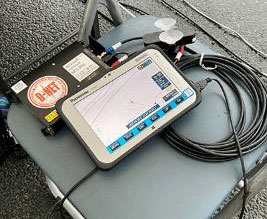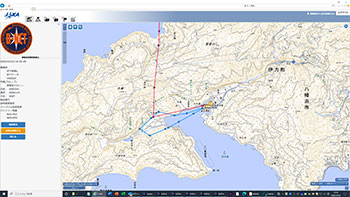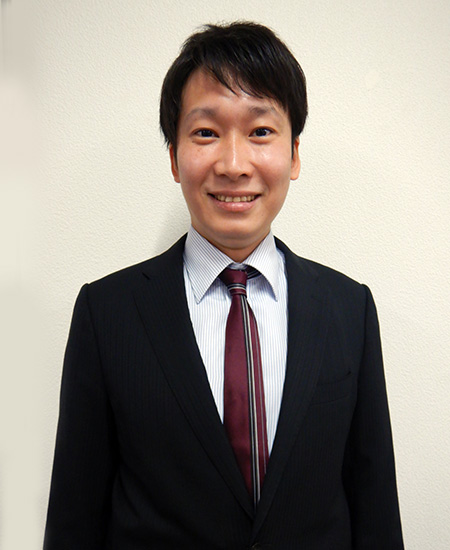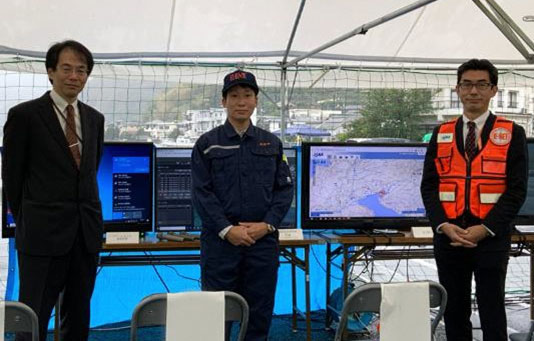Research & Development
JAXA promotes three research and development programs and a fundamental research program that underpins them.
Integrated operation system for disaster relief and crisis management (D-NET3) (FY2018-)
Flight demonstration of manned aircraft and drone integrated operations using D-NET technology held in Ikata Town, Nishiuwa District, Ehime Prefecture
In October 2020, JAXA participated in a disaster drill held in Ikata Town, Ehime Prefecture. The flight demonstration which was conducted under the collaborative agreement between JAXA and Ehime Prefecture, verified the effectiveness of D-NET’s enhanced functions aimed at further improve the information sharing between manned and unmanned aircraft systems.
Recent years have seen the increased use of unmanned aircraft systems (known as UAS, or drones) for disaster relief operations. Currently, however, there are no established technologies nor procedures to safely support integrated manned and unmanned aircraft operations. Disaster response activities in the aftermath of the heavy rains on the island of Kyushu in July 2020 revealed the undermining problems in operating manned helicopters and drones in the same airspace, in particular the difficulties in flight planning, coordination and position sharing among operators of drones and manned helicopters. The increased applications of drones recent years highlight the needs of a communication system that enables real time information sharing between operators of both manned and unmanned aircraft systems.
The disaster drill in October included two drones and a manned aircraft (helicopter), which were to perform missions in a shared airspace. First, drones were deployed to perform a reconnaissance mission. The helicopter was then to enter the same airspace, which required the drones to return to base. This coordination was enabled by D-NET’s onboard system, which allowed for an evacuation request to be sent to the drones. Drones are usually operated by UAS operators using UAS traffic management (UTM) system, and this disaster drill was no exception. By connecting UTM and D-NET systems, the drone operator can receive the evacuation request for collision avoidance through D-NET. Although the helicopter could not fly due to bad weather, the demonstration confirmed that drones can be operated safely in response to the D-NET’s evacuation request, modifying their original flight plan in-flight and returning to base safely. The drones’ position could be monitored safely via D-NET throughout the test, confirming the capabilities of D-NET for real time information sharing of both manned and unmanned aircraft for emergency responses.
JAXA will continue improving the D-NET system based on users’ feedback in order to enhance its usability and operability for aircraft operators involved in disaster response.


Message from Takeichiro Miyao
Senior staff, Nuclear Disaster Prevention Group,Nuclear Safety Measures Division,Disaster Prevention Subdepartment,Public Affairs and Environment Department, Ehime Prefectural Government
-

Takeichiro Miyao
- In the future, drones will be increasingly used, together with manned aircraft at disaster sites. Therefore, it is essential to further enhance the functionality of D-NET and UAS traffic management (UTM) systems to enable safer and more effective disaster response, including the integration of airspace between manned and unmanned aircraft. The conducted flight test was a great step forward. We were able to confirm the effectiveness of D-NET system in sharing position information between manned and unmanned aircraft and the drone could be properly operated in response to the evacuation request sent via D-NET to UTM.

From left to right of the photograph
Takeshi Ito [Director, Next Generation Aeronautical Innovation Hub Center, Aviation Technology Directorate, JAXA]
Takeichiro Miyao [Senior staff, Nuclear Disaster Prevention Group,Nuclear Safety Measures Division, Disaster Prevention Subdepartment,Public Affairs and Environment Department, Ehime Prefectural Government]
Keiji Kobayashi [Senior researcher, Disaster Relief Aircraft Technology Section, Aviation Technology Directorate, JAXA]
October 22, 2020